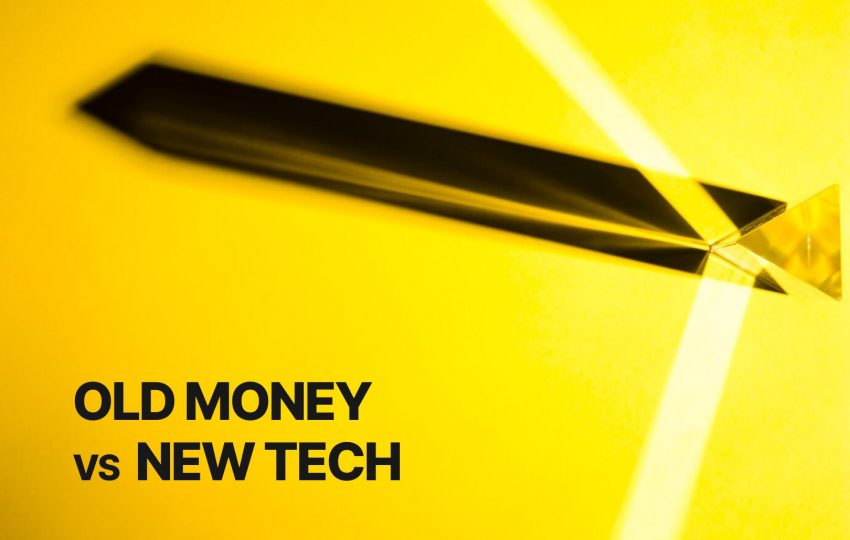Old money vs new tech

Over the past ten years, technological advancements and innovation have propelled the fintech industry from a niche player to a central force in the financial services ecosystem. The numbers tell a compelling story: valued at around USD 294.74 billion in 2023, the global fintech market is projected to grow to USD 340.10 billion in 2024 and reach an astounding USD 1,152.06 billion by 2032. With this rapid expansion, driven by accelerated digital transformation, evolving customer preferences, and increased backing from investors and regulators, fintech firms now represent a significant challenge to traditional banks across all facets of their operations.
You might think, “So what? Technological innovations have continuously transformed financial markets throughout history.” And you’d be right. However, this latest wave of disruption is an entirely different game. Rather than just building the tech for financial institutions to use in developing new products, fintech companies are now direct market players, offering innovative solutions tailored to meet the evolving needs of consumers. This seismic shift has left traditional banks scrambling to keep up, and the big question on everyone’s mind is whether they will survive the fintech revolution.
The rise of fintech: Disruption with a capital D
We live in the new age of banking, where fintechs are not just knocking on the door—they’re kicking it wide open. These agile, tech-savvy upstarts are meeting customer needs in ways traditional banks never dreamed of. From payment cards and streamlined international transfers to white label and Banking as a Service (BaaS) solutions, fintechs have redefined the meaning of banking.
What’s driving this fintech frenzy? Speed, convenience, and user-centric design. Fintech companies have tapped into the modern consumer’s desire for seamless, intuitive financial services that fit neatly into their digital lives. Need a loan? Apply online in minutes. Want to invest? Let a robo-advisor build your portfolio while you sip your morning coffee. Fintechs have made banking as easy as ordering takeout, and customers are loving it.
Fintech’s secret sauce
But what exactly gives fintechs their edge? Fintechs provide services that traditional financial institutions do less efficiently or don’t do at all, and widen the pool of users of such services. The secret sauce lies in their technological know-how, data-driven approach, and regulatory leeway. Fintechs are masters at leveraging big data and AI to offer hyper-personalized services. They know your spending habits, predict your financial needs, and tailor their offerings accordingly. This level of personalization is something traditional banks have struggled to achieve. Moreover, fintechs enjoy a lighter regulatory burden compared to traditional banks, allowing them to innovate faster. While banks are bogged down by strict compliance requirements, fintechs can experiment with new business models and technologies with relative ease.
What sets banks and fintechs apart?
The table below illustrates the main differences between traditional banks and fintech service providers across 10 key categories.
| Traditional banks | Fintechs | |
|---|---|---|
| Regulatory environment | Heavily regulated, with stringent compliance requirements. | Less regulated initially, though oversight is increasing as they expand into traditional banking services. |
| User experience | Often slower and more bureaucratic, with a focus on in-person services and established procedures. | Highly customer-centric, leveraging digital platforms to provide seamless, user-friendly experiences. |
| Personalization | Offering less personalized experiences; often one-size-fits-all. | Highly personalized experiences using data and analytics. |
| Technology adoption | Generally slower to adopt new technologies due to legacy systems and regulatory constraints. | Rapidly adopting and integrating latest technologies, focusing on innovation and agility. |
| Product offerings | Broad range of financial products, including savings, loans, mortgages, and investment services. | Typically specialized in narrow areas like payments, personal and business accounts, BaaS, robo-advisory services, and more. |
| Operational flexibility | More rigid, with established structures and processes that can limit agility and speed to market. | Highly agile, with flexible structures allowing for quick adaptation and innovation. |
| Cost structure | Higher costs due to physical branches and extensive workforce. | Lower overheads due to digital operations and a streamlined workforce. |
| Security | High levels of trust due to long-standing reputations and government backing. | Actively demonstrating that inferior security in fintech solutions is a myth by implementing robust security mechanisms. |
| Geographic reach | Extensive, with branches and ATMs in many locations. | Global reach enabled by a digital-only approach. |
| Partnerships and ecosystems | Can be limited due to regulatory constraints and legacy procedures. | Actively establishing partnerships with other tech firms and services. |
Traditional banks fighting to stay relevant
Traditional banks are responding to the changing industry dynamic with a mix of panic and perseverance. Some are launching their own digital services, while others are partnering with fintech companies to stay competitive. But innovation doesn’t come easy for these banking giants. Legacy systems, complex regulatory requirements, and a culture rooted in tradition make it hard to pivot quickly. Yet, despite these challenges, some banks are managing to stay afloat and thrive. They’re rebranding themselves as tech-forward institutions, investing heavily in digital transformation and differentiation, and acquiring fintech startups to boost their capabilities. It’s a survival tactic that’s working—for now.
The future of banking: Coexistence or extinction?
So, will traditional banks and fintechs find a way to coexist, or are we headed for a banking apocalypse?
Some experts believe a hybrid model is the answer, where banks and fintechs collaborate, each playing to their strengths. Banks bring deep pockets, regulatory expertise, and customer trust to the table, while fintechs offer innovation, agility, and cutting-edge technology. Together, they could create a financial ecosystem that’s greater than the sum of its parts.
Anyone who has used a traditional bank’s digital app will likely agree that banking giants still underestimate the significant impact that innovative products, services, and user interfaces can have on customer satisfaction and overall revenue. However, if they eventually recognize this, we might see more mergers and acquisitions as banks acquire fintech startups to enhance their digital capabilities. Alternatively, we could witness the emergence of an entirely new financial ecosystem, where traditional banks become obsolete, replaced by decentralized finance (DeFi) platforms and blockchain-based solutions.
The answer to whether traditional banks will survive fintech’s rapid rise isn’t clear-cut, as you might’ve guessed. We can only speculate on this issue based on the current trends and dynamics we are observing. Some will adapt, embracing the digital revolution and thriving in a new, tech-driven world. Others may find themselves as relics of the past, outpaced by fintechs that are faster, smarter, and more in tune with the needs of today’s consumers. However, one thing is certain: the future of banking will be anything but boring.







